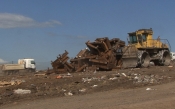
How much carbon is stored in discarded wood products buried in landfill?
It turns out to be a lot more than most people expect. The carbon in wood and composite wood products is effectively locked up for much longer than is assumed in carbon accounting schemes; acknowledging this in future accounting schemes could help increase wood’s competitive advantage.
Fabiano Ximenes from the NSW Department of Primary Industries is investigating the long-term storage of carbon in wood and paper in Australian landfills. The project is funded by Forest and Wood Products Australia (FWPA), the Australian Government’s Department of Agriculture, Fisheries and Forestry through the Forest Industries Climate Change Research fund, and Laminex.
‘We’ve been working on the issue close to 10 years now. Initially we focused on sawn wood products and the research results clearly suggest there is a high level of carbon storage in those products. This project is testing the assumption that the same levels of carbon storage would be found in composite wood products such as particleboard, MDF and plywood,’ says Fabiano.
Initially the researchers dug up wood and paper products buried for between 15 and 20 years in landfills in Sydney, Cairns and Brisbane to measure the levels of decomposition. Back in the laboratory they created ‘ideal landfill conditions’ in bioreactor jars to accurately establish how much MDF, particleboard, paper products decomposed, releasing greenhouse gases such as methane and carbon dioxide.
The research results are very exciting for timber products; MDF and particleboard show very higher carbon retention rates of around 96% to 98%. These results are in close agreement with those from a recently published study conducted in the US, which also subjected particleboard and MDF to ideal landfill conditions.
‘For these timber products our research has conclusively demonstrated that the vast majority of the carbon in the wood is retained in storage. In some ways it doesn’t matter if the product is in landfill for 10, 20, 50 or 100 years, our results are suggesting there is no difference in the levels of decomposition because there’s virtually none,’ says Fabiano. ‘We can safely claim that because of this long-term storage those products are having a real mitigation effect from a greenhouse gas perspective. We are using this as an argument to say let’s look at forest products and at the life cycle of carbon in those products, and see how we can appropriately include them in future carbon trading schemes.’
Such detailed knowledge of product-specific decomposition rates may help to increase wood’s competitive advantage in the future against other building products that release greater volumes of greenhouse gases.
Project Ref: PRB 180-0910
For more information, go to the FWPA website
